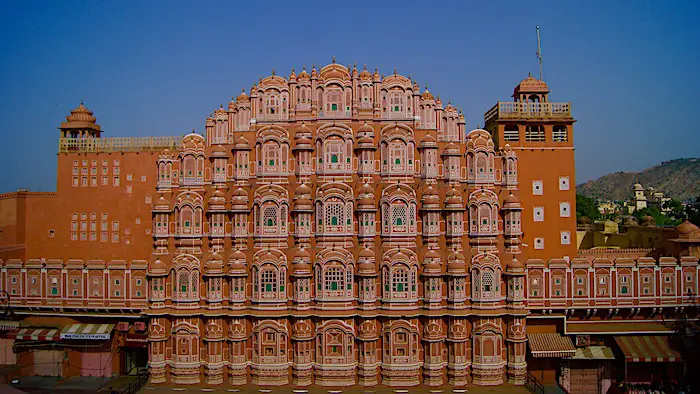The magnificent Hawa Mahal was constructed in 1799 by Maharaja Sawai Pratap Singh. Famous for being one of the best palaces in Jaipur, its name, meaning “Palace of Winds,” perfectly captures its distinctive design. With over 953 windows, visitors stand in awe as they visit the Hawa Mahal in Jaipur.
Crafted from red and pink sandstone, the palace boasts a pyramid-like structure reminiscent of Krishna’s crown. Adorned with 953 exquisite windows, known as ‘Jharokhas,’ intricately embellished latticework enhances its beauty. Inside the palace, five floors house uniquely decorated chambers.
If you are visiting India’s Pink City, Hawa Mahal is probably top of your list of must-see attractions. Although beautiful, there is more than meets the eye with this palace. And in this blog, I plan to help you make the most out of your visit and give you everything you need to know about the Palace of Winds in Jaipur!
The Palace of Winds – Quick Facts about Hawa Mahal in Jaipur:

Below are some important facts and things to know before visiting the Hawa Mahal:
- Operating Times: 9:00 a.m. – 4:30 p.m.
- Address: Hawa Mahal Rd, Badi Choupad, Pink City, Jaipur, Rajasthan 302002, India
- When was the Hawa Mahal built: 1799
- Who created the Palace of Winds: Maharaja Sawai Pratap Singh
- Why was the palace built: For the royal women to see the events and festivals in the street below
- Architectural Style: Blend of Hindu Rajput architecture and the Islamic Mughal architecture
- What is the Height of the Hawa Mahal: It has a height of 50 feet
- Age of Hawa Mahal: 224 years
What is the entrance fee for the Hawa Mahal?
- Indians: Rs. 52
- Foreigners: Rs. 202
- Indian Students: Rs. 22
- Foreign Students: Rs. 102
Tourist Composite Ticket Price:
- Indian: Rs. 420, Foreigners: Rs. 1100
- Indian Students: Rs. 110, Foreign Students: Rs. 550
How Much is the Entry Fee to the Hawa Mahal?
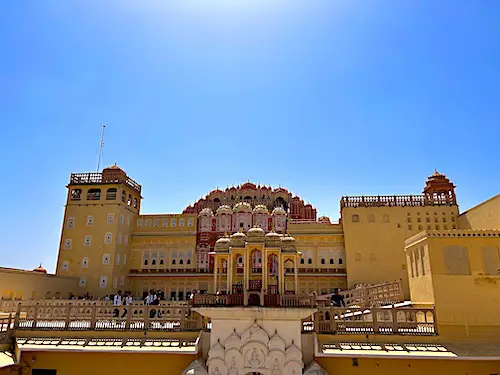
The entry fee is INR 10 for Indians and INR 50 for foreigners. Additionally, Tourist Composite Tickets are available, giving access to multiple monuments in Jaipur. Composite tickets are INR 100 for Indians and INR 400 for foreigners.
Tourist Composite Tickets can be a great way to save money and time when purchasing tickets for the most famous tourist attractions in the Pink City. The Tourist Composite Tickets will give you access to the following monuments in Jaipur:
- Amber Palace
- Jantar Mantar
- Hawa Mahal
- Nahargarh
- Albert Hall Museum
- Sisodia Garden
- Vidhyadhar Garden
When is the Best time to visit the Palace of Winds?
The best time to visit Hawa Mahal is in the early morning when it is less crowded and the early morning sun enters the rooms from the windows.
However, please note that the palace is accessible to visitors from 9 a.m. to 6 p.m. If you wish to capture photographs of Hawa Mahal before this, a few cafes are open across the street during the early morning hours.
Another thing to remember when considering visiting Jaipur, in general, is the climate. During the summer, the city is almost unbearable to live in, with temperatures reaching upwards of 43 C (110 F!) Believe me, it is hot during these months. I lived in Jaipur from May to July, and it was over 100 F most days, making it hard to get out and about during the day!
History of the Hawa Mahal

In 1799, Maharaja Sawai Pratap Singh commissioned the construction of Hawa Mahal as an extension of the City Palace. Designed by Lal Chand Ustad, the architectural masterpiece took the form of Krishna’s crown.
During that era, the Rajputs adhered to the Purdah system, which meant that the royal women remained concealed from public view. However, desiring to stay connected with the outside world and witness daily events, the Hawa Mahal was ingeniously crafted with over 900 windows and screened balconies. These architectural elements gave the women a sense of liberation and freedom within its walls.
The architecture of Hawa Mahal

Hawa Mahal derives its name from its remarkable architectural features, making it one of the most famous places to visit in Rajasthan.
This five-story palace resembles a honeycomb, boasting 953 small windows called jharokhas. These intricately designed windows not only lend to the palace’s unique appearance but also to the functionality of the building where. The windows help facilitate wind flow throughout the palace, keeping it cool during the scorching summers.
Standing at an impressive height of 50 feet above the ground, Hawa Mahal is the world’s tallest foundation-less building. Due to the absence of a foundation, the palace is tilted at an angle of 87 degrees.
Even though the palace is about 50 feet in height, Hawa Mahal has no stairs. Instead, ramps allow one to move between the floors. This is because the palace was constructed for the royal women living there during the time of the Rajputs. However, they were adorned with intricately embellished jewelry and donned elaborate traditional attire, limiting their mobility. Additionally, it allowed the servants to move from floor to floor while they carried supplies for the royal women.
The top three floors of Hawa Mahal consist of rooms that are merely the width of a single chamber, while the first and second floors feature courtyards in front of them. These rooms are adorned with vibrant mosaics, ornamental stonework, and traditional Rajasthani architectural elements known as “chhatris.”
In the section below, I go into further detail about the interior of the Hawa Mahal and its impressive interior.
Exploring the Interior of the Hawa Mahal in Jaipur
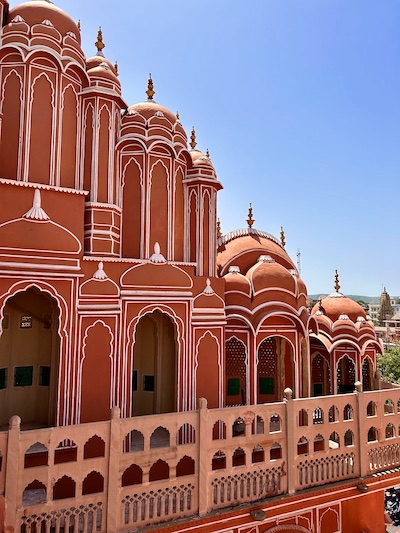

While the exterior of Hawa Mahal is the first thing that captivates visitors, it is the interior that showcases the ingenuity and brilliance of when the palace was built. With its simplistic and practical designs, the interior allowed for comfortable living in the Palace of Winds in the desert of Rajasthan.
Nevertheless, the interior is adorned with remarkable details and offers breathtaking cityscape views. Additionally, the palace comprises five floors, each showcasing a delightful fusion of Islamic, Mughal, and Rajput architectural styles.
To begin with, as you enter Hawa Mahal, you will pass through a humble-looking gate called Anand Pol, located at the backside facing one of the entrances to Jaipur’s City Palace. Once inside, you will be greeted by a second gate named Chandrapoli, adorned with domed arches intricately carved with depictions of gods and goddesses.
Without further ado, let’s dive into each of the five floors and discuss what each has to offer! Along with fascinating facts and must-see spots within the complex.
Ground Floor of the Hawa Mahal: Sharad Mandir
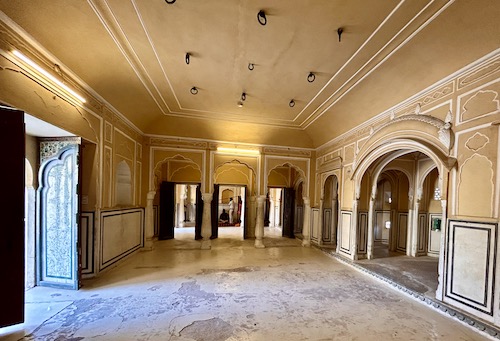
As you step through the gates of Hawa Mahal, the captivating Sharad Mandir welcomes you on the palace’s ground floor. With a beautiful courtyard adorned with a central fountain, the ground floor will already have you captivated by the ambiance of a bygone era. The name “Sharad Mandir” is derived from the autumn season, which was a time of joyous celebrations often hosted within this very courtyard.
In addition to the courtyard, there is an archaeological Rajputi museum accessible from the main courtyard. Established in 1983, this museum provides a fascinating insight into the vibrant Rajputi culture. As one of the must-visit museums in Jaipur, It proudly displays a remarkable collection of antiques, ancient weaponry, intricate miniature paintings, swords, and various other historical artifacts.
A little tip for you while exploring the museum and ground floor is to keep an eye out for the exquisitely decorated doors that are hidden away. These hidden gems are a true marvel and should not be missed. Take your time to appreciate their stunning craftsmanship and intricate details.
Second Floor: Ratan Mandir
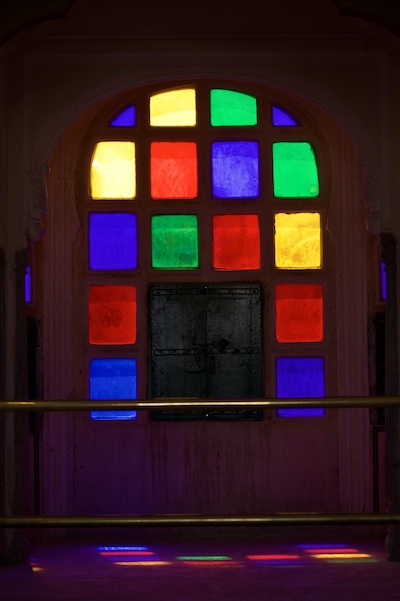
To ascend to the second floor, reminiscent of royalty, you will have to traverse the ramps as there are no stairs in the palace. The name “Ratan” translates to “gem” in Hindi, and this floor of the Hawa Mahal truly lives up to its name.
Stepping onto the pavilion, you will be greeted by stunning, jewel-like stained glass arches adorning each window. In the morning and throughout the day, you will be able to see the colorful windows cast vibrant rainbows, illuminating the entire interior of the Ratan Mandir.
Additionally, on the second floor, you will see jharokhas, or windows, providing open views of the streets below. A balcony encircles the outer perimeter, allowing you to peer down into the courtyard below and see the sights from a unique perspective.
Third Floor of the Palace of Winds: Vichitra Mandir
The third floor, known as Vichitra Mandir, derives its name from its intriguing qualities. “Vichitra” translates to “unknown” or “weird.” And without knowing the history behind the palace, this may seem like a strange name to some.
However, this floor served as Maharaja Sawai Pratap Singh’s private sanctuary, where he could retreat from the pressures of his royal title. Behind closed doors, he would indulge in activities such as composing poems, singing, and worshiping his beloved deity, Lord Krishna.
Although it may not appear particularly peculiar to us today, seclusion and solitude were considered unconventional during that era. Additionally, as this was his personal space, the rooms are much simpler than the other elaborate pavilions or notable sights throughout the structure.
As you ascend higher from here, the passages become steeper, windier, and narrower, presenting more challenging navigation.
Fourth Floor: Prakash Mandir
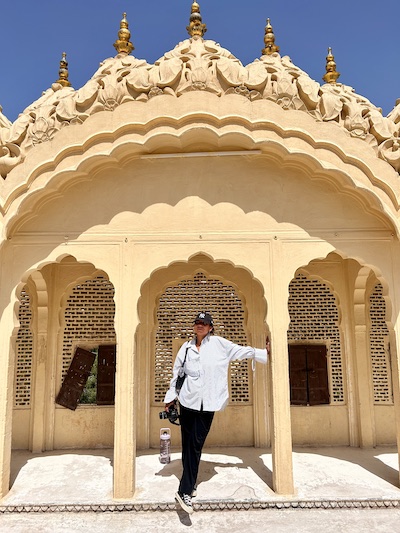
Prakash Mandir on the fourth floor of the Hawa Mahal is where you will start to be really impressed! “Prakash” translates to “light,” and as you escape the narrow passages from the floors below, you are greeted by a spacious open-air area bathed in sunlight.
The delightful viewing platforms, though small in size, are adorned with captivating chhatris and dome-shaped pavilions that add to the charm of the palace. Here, you can capture photographs and imagine yourself as a Rajput royalty!
Unveil the little green wooden doors and peek through one of the 953 peep-hole-sized jharokhas. These tiny windows continue to offer glimpses into the lives of the people of Jaipur, just as regal and ethereal as they were centuries ago!
Fifth Floor of the Hawa Mahal: Hawa Mandir
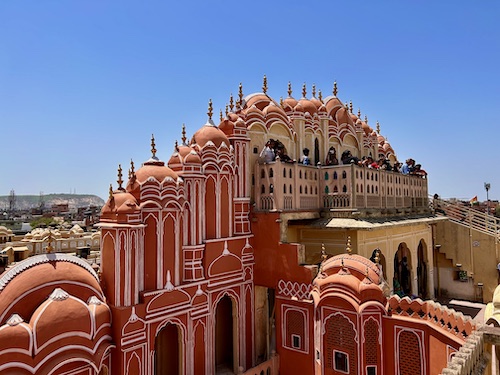
On the fifth and final floor of the palace, you can indulge in the breathtaking panoramic views of Jaipur. Commonly known as the Hawa Mandir, you can view the city from a small area accommodating around ten or fifteen people at a time. Alongside the captivating views, Hawa Mandir boasts ornate domes adorned with intricate detailing, adding to its beauty.
The name “Hawa” refers to wind, and this floor was aptly named due to the refreshing breezes that prevail up here. From various vantage points, you can marvel at the splendid city vistas on one side while catching glimpses of the enchanting Jantar Mantar, City Palace, and Nahargarh Fort on the other.
Don’t Miss the Sculpture Gallery!
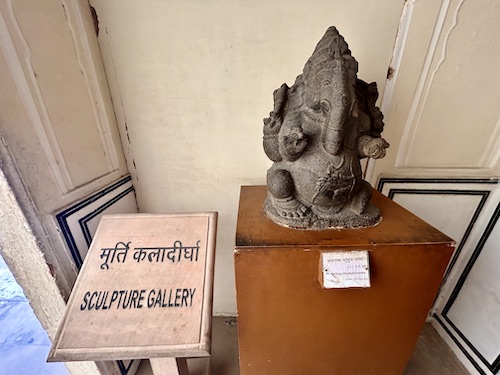
After you exit the main part of the palace where you can go to the top of the Hawa Mahal, you will find an extra exhibit! We had no idea about this portion of the palace and almost missed it.
The sculpture gallery or museum as a few artifacts to see, which are nice and informative. However, the best part is that you can explore more of the palace, by walking on the outer walls that sprawl out along the roads.
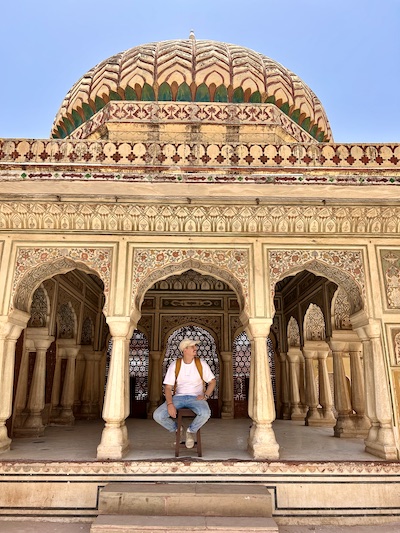
For me, this might have been the best part of the palace, as it was not crowded at all. It also showed some really nice courtyards, as well as intricate domes and seating areas to relax in. It was really nice to take photos with no one else in them, and to explore the area without the noise.
Other tourist destinations close to the Palace of Winds:
There are plenty of other tourist destinations around Hawa Mahal. These include:
- Jantar Mantar
- Govind Devji temple
- Amer Fort, Nahargarh Fort
- Ram Niwas Bagh
- BM Birla Planetarium
- Jain Temple
- Statue Circle
- Sisodia Rani Garden
Eating at the Palace of Winds

There are two famous cafes that face the palace and provide amazing views of the architecture. One is the Tattoo Cafe, and the other is Wind View Cafe. Both are elevated above the street and allow you to get a different perspective of the palace.
We visited the Tattoo Cafe for breakfast, and found that it was very expensive. To be honest it was the one thing that we regretted about our trip to the Hawa Mahal, because we ended up spending around INR 800 for two small drinks and a smoothie bowl. Although not super expensive, the price did not match the portion or quality of the food. They also have a minimum order of INR 500 rule at the cafe.
The better option is to forego the cafes out front and just have some snacks at the cafe inside the palace. They have sandwiches, pizza, and other snacks for much cheaper! We saw a lot of locals eating at this cafe – for comparison, we were the only people in the Tattoo Cafe.
Shopping around the Hawa Mahal
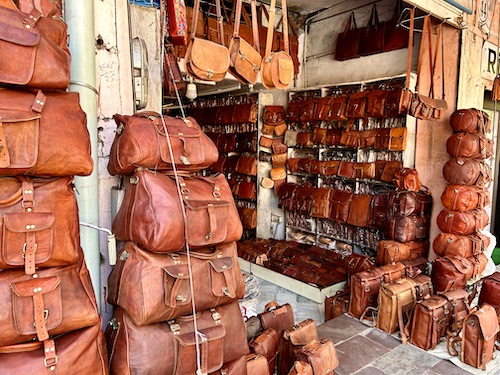
If you still have energy, and looking for some excitement after visiting the palace, there are some great shopping opportunities outside Hawa Mahal! Whereas, just outside, a bustling hub of small shops awaits, offering a wide array of gift items and daily essentials. This vibrant shopping area, known as Badi Chaupal or Manek Chowk, are some of the best places to shop in Jaipur.
Here, you’ll discover a plethora of articles, including traditional clothing, jewelry, showpieces, vases, traditional footwear known as ‘juttis,’ key chains, and various other items. The market also boasts a range of Jaipuri printed dress materials, sarees, jewelry, handicrafts, Rajasthani furniture, and antiques.
As you explore the area, tantalizing aromas waft from street vendors who entice passersby with delectable snacks such as golgappas, bhelpuri, samosas, and kachoris. These culinary delights are a delightful treat for your taste buds.
The Hawa Mahal: A popular tourist destination in Jaipur Rajasthan
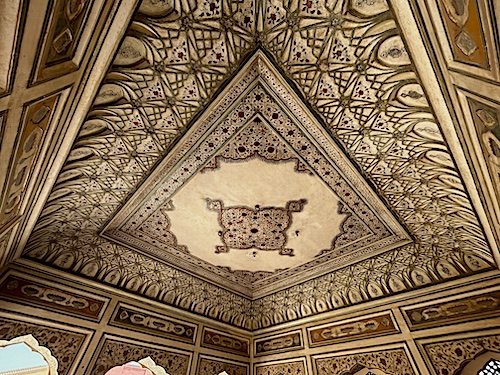
The Hawa Mahal, or Palace of Winds, is an absolutely stunning structure that has been attracting tourists for years. With its over 900 windows, one can peer out through them to take in the cityscape below, just as the royal women did centuries ago.
This is by far one of the top things to do in Rajasthan due to its beautiful and unique structure and history. I absolutely loved the Hawa Mahal when I visited, as it was nothing like anything I had seen before. It was built over 200 years ago and is still in amazing shape, which allows you to transport yourself to the Rajput area in Jaipur.
FAQs: Hawa Mahal in Jaipur
Below are some of the most frequently asked questions regarding the Palace of Winds in Jaipur.
The Hawa Mahal is special as it is a tribute to Lord Krishna. With its distinctive structure believed to resemble the divine crown adorned by the deity. Beyond being a mere palace, this magnificent edifice embodies a captivating fusion of the Hindu Rajput and Islamic Mughal architectural styles, exemplifying a harmonious blend of cultures and artistic brilliance.
The name of the palace was derived from its breezy surroundings. Its architectural composition thoughtfully integrates numerous windows, jharokhas, and intricate latticework, allowing for excellent ventilation and facilitating the unrestricted passage of refreshing winds.
Within the Hawa Mahal, every floor houses a splendid temple. The presence of the Sharad Mandir graces the first floor, while the second floor boasts the vibrant Ratan Mandir adorned with captivating glasswork. The upper three floors are adorned with the exquisite Vichitra Mandir, Prakash Mandir, and Hawa Mandir. Interestingly, no conventional staircases lead to the upper floors of the palace.
There are no stairs in the Hawa Mahal as the royal women living there were adorned with intricately embellished jewelry and donned elaborate traditional attire, limiting their mobility. Additionally, it allowed the servants to move from floor to floor while they carried supplies for the royal women.
